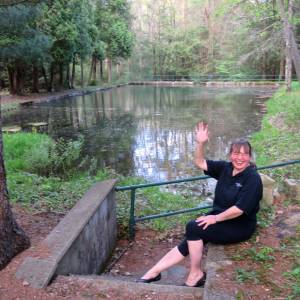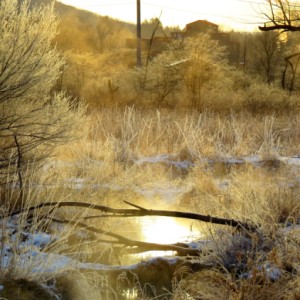Millbrook Marsh on a Frigid Morning
It's time for some real February winter weather. We are plunging into the polar vortex this weekend. Or perhaps it is plunging into us. They're expecting that Saturday night's low temperatures may set records. And so our weekend's entertainment may simply be sitting indoors, watching in fascination as the mercury drops. Don't we know how to have fun!? ;-)
We've had a bit of snow here and there. Not much, just a skiff or an inch or so now and again. Squalls move in and lay down a fast layer of snow that looks pretty, makes a mess of traffic, then disappears by mid-day. We had mild temperatures last weekend, but by the end of this work week, they were already starting to dip.
It was between 5 and 7 degrees F on Friday morning when I got up, and I was headed into work, but I thought if I left a bit early, I might be able to fit in a quick stop along the way. One of my favorite cold-weather spots is Millbrook Marsh, and that's where I went.
And I was treated to a fine display of frost mist rising, which is a thing that absolutely tickles my fancy. This particular shot is of Thompson Run, which flows through the marsh, with the trees and bushes silvery-white with hoar frost and with mist rising from the run. I've included a second photo in the extras. I'm in heaven when I'm watching the frost mist rise like angels into the light . . . though it's a cold, cold heaven, to be sure.
Nobody has ever really asked me for tips on cold-weather photography, but I thought that what I do on these mornings might be a niche market sort of thing, and perhaps some explanation of how I do what I do may be of use to others who are interested in doing such a thing themselves. So here they are:
10 Tips for Ultra-Cold-Weather Photography
1. Be very aware of the weather forecast and the timing of celestial events. I am obsessed with the weather, and I watch the online weather radar maps like a hawk. Every day. All day. In winter, it's not just for safety's sake, though that's important. I want to know when it's going to be ultra-cold, when it's expected to snow, when the full moon is due, what time is sunrise. If you want to photograph these natural phenomena, KNOW them. Really KNOW them, like a lover. Such knowledge can bring you great photos. It can also save your life.
2. Have a few locations in mind that might be good for cold-weather shooting. Are there snow scenes that you'd love to photograph in morning light? A special tree that will really pop when shot against dramatic morning clouds? Places that have flowing water are good for the mist rising phenomenon; a marsh is a good example. You can usually spot a good hoar frost from a distance by the white or silver on the trees; when the sun hits the mist, it will rise into the light. Where do you want to be standing when it happens? It's hard to find actual liquid water in winter, but if you find it, it's a bonus: reflections on water double the light.
3. Dress warmly for conditions. And at 5 degrees, I'm talking LAYERS. In winter, I often wear one set of (WARM!) clothes into the office and change into something more appropriate once I'm there. I have very lightweight Duofold long underwear that is comfy and warm. I have polar fleece pants. A big Woolrich coat with a hood. Leg warmers. Thermax. Gore-Tex. Insulated boots with grippy soles. And of course, gloves. Yes, you are going to have to learn to master your camera's basic functions while wearing GLOVES. Because nobody - no, nobody - can be bare-handed at 5 degrees; you'll get frostbite, and that'll be no fun at all! (And if it is actively precipitating, let me add this: take an umbrella to protect the camera!)
4. Travel with a hot coffee (or other large hot beverage of your choice) in a big cup or thermos. It will be delightful to come back to the car to once you're done taking your pictures.
5. Be very aware of the parking that is available near where you want to take pictures. You will need to assess instantly whether the parking area is safe to park in. Is there an inch of snow? Probably fine. Is there ice beneath it? Maybe not so fine. Know where to park safely so you don't worry about getting back out once you got in. And winter, at 5 degrees, is NO TIME to lock your keys in the car. So carry your keys and carry EXTRA keys. I keep a spare car key in my camera bag because, yeah, I've been there and done that: nothing spoils a nice photo shoot like the embarrassment of having to arrange your own rescue from a parking lot you didn't even need to be in, in the first place!
6. Make sure your camera is ready for the adventure. At these temperatures, you're probably not going to be able to be fussing with changing lenses or batteries. So be sure before you leave the house that you have the lens on that you want and that your battery is fully charged. My camera is not an SLR so I don't ever worry about changing lenses. And I have three batteries for it, one of which is an all-star that gets about 600 shots per charge. So that's my go-to battery for cold weather, or any sort of challenging weather photo shoot. And I wear the camera out, around my neck, and ON, for the entire adventure. I get it out and put it on the instant I leave the car; I also carry a camera bag to tuck it into if the weather should turn sour.
7. Be careful not to steam up the camera or lens. This is a thing you can do yourself by handling it with warm hands or by breathing on it. It can take a while to un-steam it. So just don't go there. Also, if you're planning multiple stops during your drive, if you get out of the car in cold weather, take a bunch of shots, and then jump back into a well heated car, the lens will steam up and for a while after that, you will get BUPKIS! Nada. Diddly squat. When I am planning multiple stops, I often keep the car heat on low and the windows down. Yes, it's odd behavior, but cold weather demands extreme precautions!
8. When you get to your location, set a time limit on your adventures and stick to it (and wear a watch!). For me, because I'm usually on my way to work, that's usually about 20 minutes or so. Although it can be as short as 5 minutes (in which case, I let the car run - but be careful not to let the door lock behind you! - leaving the windows down is not a bad idea), or as long as 30 minutes. For a cold-weather shoot, you are not going to be out for hours and hours. You just can't be in these conditions. Keep it short and positive.
9. Watch for the good light. The winter phenomena such as frost mist are most effectively captured in good light. (Isn't that about the case for EVERYthing!?) Especially backlit. The marsh is a good place to shoot because the morning sun rises over Mount Nittany and then I get good light on the run and on the mist. So use the light to its best advantage and try a bunch of camera settings to maximize it. Any shot I really like, I usually shoot at least three ways: automatic, monochrome (black and white), and vivid (extra color saturation). You can decide later which method is best to convey what you saw and experienced. But don't pick just one mode, as you may look at the photos later only to discover lots of pink sun spots or some other issue. I shoot straight into the sun a lot, so the sun motes are a big concern. I usually throw away a half-dozen shots or more from every morning photo shoot due to sun motes.
10. Be aware of your environment and the creatures around you. Are there ducks on the run? Is there a heron around the corner, fishing? Is there a muskrat nearby, swimming on the high waters? Is there a bird overhead? Don't miss the show. And keep the camera out until the very end, as I often find that the marsh gives me one last gift just as I leave the boardwalk. On this morning, it was a hawk overhead. :-)
I hope these tips help you have a good cold-weather photography experience! And of course, it goes without saying that you should HAVE FUN! :-) I'll include links to a few of my recent cold-weather shots:
Morning Light on Water, with Frost Mist Rising
Millbrook's Cold Fire: Frost Mist Rising
Along Spring Creek: Angel Mist Rising
And of course, this is the photo that started it all for me, as I fell in love with the marsh and the mist and all that is beautiful about cold, cold winter:
Millbrook: Frost Mist Rising in the Morning Sun
The song to accompany this posting is Annie Lennox, with Cold.


Comments
Sign in or get an account to comment.


